
Growing up in Olapalayam, an isolated area of southern India, a diagnosis of type-I diabetes at age 12 left Sampathkumar (Sampath) Rangasamy, Ph.D., with a deep desire to help those with rare diseases.

How growing up in an isolated area of southern India as a type-I diabetic shaped the life and career of Sampath Rangasamy, Ph.D.
Growing up in Olapalayam, an isolated area of southern India, a diagnosis of type-I diabetes at age 12 left Sampathkumar (Sampath) Rangasamy, Ph.D., with a deep desire to help those with rare diseases. Diabetes doesn’t qualify as “rare” in the West, but in a remote farming village in India it does, and it instilled an empathy in Rangasamy that allows him to identify with the children his research at TGen’s Center for Rare Childhood Disorders (C4RCD) seeks to benefit.
“Children with rare, undiagnosed disorders come to the clinic, after going from doctor to doctor without a diagnosis,” Rangasamy explains of his work. “These families undergo tremendous stress.”
Often referred to as a diagnostic odyssey, parents and child contend with the symptoms of a mysterious disorder that goes unidentified visit after visit, year after year. Now, genomic sequencing and other technologies have virtually eliminated this hardship by identifying the genetic cause of a disease so that many parents can have peace of mind in as little as 24 hours—after nearly a decade of struggle.
Rangasamy can relate.
For his family, the “diagnostic odyssey” was a literal journey. They traveled some 30 miles through the rugged backcountry, navigating unnamed streets and winding dirt paths, to secure a diagnosis. There was no refrigeration in Olapalayam, so his mother cleverly engineered a system of storage that kept the insulin in clay pots, one nested inside another, three deep, with the outer two in water to keep the center cool. “My Mom was innovative at the time,” Rangasamy observes.
These experiences throughout his formative years have shaped much of his work at C4RCD and beyond. Trying to ease the pain for families facing challenges similar to his own.
Helping Families Move Forward
Rangasamy received his Ph.D. in Biochemistry from the University of Madras, India. After, he traveled to the States for the first time, completing his post-doctoral training through the University of New Mexico and eventually settling in Arizona. Initially, he went to the Barrow Neurological Institute (BNI) before joining TGen’s Neurogenomics Division at the Center for Rare Childhood Disorders (the Center).
At the Center, his work focuses on investigating cellular and molecular mechanisms underlying neurogenetic disorders. Rangasamy uses genetic sequencing to reach a diagnosis faster.
“My work can also play an important role after diagnosis,” Rangasamy explains. “One aspect is gene therapy. Let’s say they have a mutation in a single gene, and there is no therapeutic for them. We are developing this new technology where you put the correct gene into a virus, then the gene will enter the body and replace the gene’s bad copy with the correct copy.”
Fundamentally, gene therapy replaces a faulty gene or adds a new one in an effort to cure a disease or enhance the body’s ability to fight the disease on its own.
Viruses deliver the therapy, as they are highly effective vehicles for introducing genetic material into cells. Scientists first remove the ability of the virus to cause infectious disease, then they equip it with a “payload” that includes the therapeutic genes.
Presently, Rangasamy is focusing on several areas to develop gene therapy for rare disorders.
App Guided by Personal Experience
Rangasamy has developed other health technologies as well.
Diabetes results when the body’s ability to produce insulin on its own fails. Managing the disease requires insulin therapy to control the blood glucose level. Failure to maintain insulin balance can affect the bodies organs and lead to debilitating or life-threatening situations.
In order to maintain control, insulin pump technology replaced insulin injections to automate much of the process for those with both type 1 and type 2 diabetes. It operates like an externalized pancreas. The downside includes relocating the pump every 48 to 72 hours in a different area of the body. Usually, patients document these rotating positions in a small journal, but human error often leads to issues. People get busy and lose track of the details. A pump located in the same position on the body too many times in a row can lead to skin irritation, rashes, and other complications.
Rangasamy partnered with a friend, mathematician John Blanchard, to develop an app that guides users on where to place insulin pumps, insulin pens, and glucose monitors. It also keeps track of their position history to enable site rotation. Rangasamy has been using it personally for more than three years now.
The app, currently making its way through the patent process, could have utility for other diseases, including multiple sclerosis, cancer, or anything that needs biological injections.
Moving Full Circle
For Rangasamy, his illness and the challenges it posed provided the inspiration for innovations that have driven his career. From using genomics in the C4RCD Lab to give families peace of mind, through faster diagnosis to helping develop treatments that enlist the body in the healing process, and now, the development of an app that helps make diabetes more manageable. The joys, the inspiration and the hardships that he and his family encountered have become the motivation for discovery.